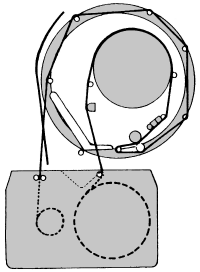Designed in the late sixties/early seventies the U-matic format was the fore-runner to all home video formats. It is based on a revolutionary U-wrap tape lacing system which specifies a video drum diameter of 11cm giving a tape writing speed of 8.54 meters per second. Interestingly, unlike the Betamax format which was to follow, the spools of a U-matic video cassette rotate in the same direction.
The format was intended for professional use and so advanced features enabling full editing functionality were designed into the system from the start. Because it uses a 3/4 inch wide tape the video cassette size is large and the running times are low when compared to the domestic formats. However it is precisely because of the larger dimensions of the tape and drum that the stability and robustness of the format are so high.
The format has developed during its lifetime. Sony has brought out several model ranges of machines over the years to take advantage of new developments in tape and video technology.

U-wrap tape lacing
| Basic U-matic System Data | |
|---|---|
| Tape Width | 3/4 inch |
| Drum Diameter | 110.00 mm |
| Speed of Head Disc | 1500 rev/min |
| Video head to Tape Speed | 8.54 m/s |
| Tape Speed (PAL) | 9.53 cm/s |
| Video Track Width | 0.83 mm |
| Guard band width | 0.070 mm (Lo-band) 0.040 mm (Hi-band) |
| Audio Track Width | 0.8 mm |
| Audio Frequency Response | 50Hz - 15kHz |
| Maximum Recording Time (PAL) | 74mins (Lo-Band) 60 mins (Hi-band) |
| S/N Ratio | > 46dB |
| Horizontal Resolution | > 250 lines |
| Angle of Video Tracks | 4° 58' 06" |
| Converted Sub-carrier | 685.991 (Lo-band) 983.803 (Hi-band) |
| End Sensors | Optical |
There are three U-matic variants: Low,
The original U-matic format is known as Lo-Band. The Hi-band system uses increased frequency carriers for improved picture quality and was the very first cassette based broadcast video format. SP, which stands for Superior Performance, is a further enhanced variation on the format which uses chrome tape for better video response and lower noise. This range is exemplified by units such as the BVU-950
Today, with the exception of a few African broadcasters, the SP variant is all but dead. The Low and Hi Band versions live on though. Hi Band is still used in studios as a companion to Betacam and Lo Band is firmly established amongst advertisement agencies and corporate establishments as the industry standard presentation format because of its reliability when compared to domestic alternatives.
Low and Hi-band formats are not interchangeable. Whilst they use the same size tapes a Hi-band recording will play back in black & white on a Lo-band machine. The situation is further complicated by numerous modifications on the market which allow Lo-Band VTRs to work with Hi-Band tapes and visa-versa.
Many U-matic VTRs have also found homes with enthusiasts. This is probably because the older series machines are available at very reasonable prices and provide excellent editing capabilities.
